Vibrational Characteristics of a Foam-Filled Short Basalt Fiber Reinforced Epoxy Resin Composite Beetle Elytron Plate
Abstract
:1. Introduction
2. Sample Preparation and Experimental Method
2.1. Sample Design and Preparation
2.2. Modal Experiment
2.3. FE Simulation of Two Sandwich Plates under a Transverse Load
3. Results and Discussion
3.1. Results and Analysis of the Vibration Experiment of the HPfc and EBEPfc
3.2. FE Analysis Results and Discussion
3.2.1. FE Analysis Results
3.2.2. Internal Mechanism Influencing the Vibrational Characteristics of the EBEPfc
4. Conclusions
- (1)
- The first and second natural frequencies of the EBEPfc were lower than those of the HPfc, but they were very close, and the first two modes were the same. The first- and second-order damping ratios of the EBEPfc were greater than those of the HPfc, and the vibrational response was significantly less than that of the HPfc. Therefore, the EBEPfc not only had a better vibration damping performance than HPfc but could also directly replace the HPfc to improve the vibration damping and seismic performance in practical engineering applications.
- (2)
- Although the foam was weak, it reduced the shear force proportions of the core skeleton and the skin and its fluctuation range in the cycle. It enhanced the shear stiffness of the overall core structure, and further improved their static and dynamic performance. The foam played a positive role in protecting the core skeleton and skin. Additionally, the foam had a greater enhancement effect on the HPfc because the trabeculae inside the EBEPfc could bear more shear load, that is, the synergy between the trabeculae structure and foam bore more shear force.
- (3)
- The vibrational performance of EBEPfc was better than that of the HPfc, because the equivalent cross-sectional area of the trabeculae area of the core was greater than that of the HPfc. Thus, the shear modulus, shear stiffness and shear force proportion of the core skeleton were greater than those of the HPfc. As a result, the EBEPfc had a better static and dynamic performance, a lower shear strain energy per unit volume and a greater damping ratio than the HPfc. Additionally, the EBEPfc exhibited greater stress amplitude fluctuation in the dynamic response. This resulted in more intense friction, more energy dissipation and a greater damping ratio in the material, which also led to a better vibrational performance of the EBEPfc. The results of this study provide useful guidance for further research and applications of the EBEPfc in the future.
Author Contributions
Funding
Institutional Review Board Statement
Informed Consent Statement
Data Availability Statement
Conflicts of Interest
References
- Bai, Z.; Wang, D.; Xu, Z. Model Creation of Strain Rate–Dependent Energy Absorption for Paper Honeycomb Sandwich Structure. J. Sandw. Struct. Mater. 2015, 17, 359–375. [Google Scholar] [CrossRef]
- Xu, M.; Liu, D.; Wang, P.; Zhang, Z.; Jia, H.; Lei, H.; Fang, D. In-Plane Compression Behavior of Hybrid Honeycomb Metastructures: Theoretical and Experimental Studies. Aerosp. Sci. Technol. 2020, 106, 106081. [Google Scholar] [CrossRef]
- Taylor, E.A.; Glanville, J.P.; Clegg, R.A.; Turner, R.G. Hypervelocity Impact On Spacecraft Honeycomb: Hydrocode Simulation And Damage Laws. Int. J. Impact. Eng. 2003, 29, 691–702. [Google Scholar] [CrossRef]
- Cai, Q.; Ma, K.; Shen, B.; Liu, Z.; Zhao, Y. Natural Frequency Analysis of the Honeycomb Type Steel Open-Web Sandwich Plate Floor Based on Vibrate Comfort Requirement. Build. Sci. 2017, 33, 1–7. [Google Scholar]
- Monajemi, H.; Mazinani, I.; Ong, Z.C.; Khoo, S.Y.; Kong, K.K.; Karim, R. Using Local Stiffness Indicator to Examine the Effect of Honeycombs on the Flexural Stiffness of Reinforced Concrete Beams. Measurement 2015, 64, 157–162. [Google Scholar] [CrossRef]
- Baba, B.O.; Thoppul, S. An Experimental Investigation of Free Vibration Response of Curved Sandwich Beam with Face/Core Debond. J. Reinf. Plast. Compos. 2010, 29, 3208–3218. [Google Scholar] [CrossRef]
- Tanimoto, Y.; Nishiwaki, T.; Shiomi, T.; Maekawa, Z. A Numerical Modeling for Eigenvibration Analysis of Honeycomb Sandwich Panels. Compos. Interfaces 2001, 8, 393–402. [Google Scholar] [CrossRef]
- Mozafari, H.; Najafian, S. Vibration Analysis of Foam Filled Honeycomb Sandwich Panel—Numerical Study. Aust. J. Mech. Eng. 2019, 17, 191–198. [Google Scholar] [CrossRef]
- Gibson, L.J.; Ashby, M.F.; Schajer, G.S.; Roberston, C.I. The Mechanics of Two-Dimensional Cellular Materials. Proc. R. Soc. London. A. Math. Phys. Sci. 1982, 382, 25–42. [Google Scholar] [CrossRef]
- Fu, M.; Yin, J. Equivalent Parameters of the Honeycomb Core Layer. J. Mech. 1999, 31, 113–118. [Google Scholar]
- Mindlin, R.D. Influence of Rotatory Inertia and Shear on Flexural Motions of Isotropic, Elastic Plates. In The Collected Papers of Raymond D. Mindlin; Springer: New York, NY, USA, 1989; Volume I, pp. 225–232. [Google Scholar]
- Ghiţă, C.; Pop, N.; Popescu, I.N. Existence result of an effective stress for an isotropic visco-plastic composite. Comput. Mater. Sci. 2012, 64, 52–56. [Google Scholar] [CrossRef]
- Marin, M.; Fudulu, I.M.; Vlase, S. On some qualitative results in thermodynamics of Cosserat bodies. Bound. Value Probl. 2022, 1, 1–15. [Google Scholar] [CrossRef]
- Florence, A.; Jaswin, M.A. Vibration and Flexural Characterization of Hybrid Honeycomb Core Sandwich Panels Filled with Different Energy Absorbing Materials. Mater. Res. Express 2019, 6, 075326. [Google Scholar] [CrossRef]
- Boucher, M.-A.; Smith, C.W.; Scarpa, F.; Rajasekaran, R.; Evans, K.E. Effective Topologies for Vibration Damping Inserts in Honeycomb Structures. Compos. Struct. 2013, 106, 1–14. [Google Scholar] [CrossRef]
- Burlayenko, V.N.; Sadowski, T. Dynamic Behaviour of Sandwich Plates Containing Single/Multiple Debonding. Comput. Mater. Sci. 2011, 50, 1263–1268. [Google Scholar] [CrossRef]
- Sadowski, T.; Bęc, J. Effective Properties for Sandwich Plates with Aluminium Foil Honeycomb Core and Polymer Foam Filling—Static and Dynamic Response. Comput. Mater. Sci. 2011, 50, 1269–1275. [Google Scholar] [CrossRef]
- Arunkumar, M.; Pitchaimani, J.; Gangadharan, K. Bending and Free Vibration Analysis of Foam-Filled Truss Core Sandwich Panel. J. Sandw. Struct. Mater. 2018, 20, 617–638. [Google Scholar] [CrossRef]
- Kao, J.-Y.; Chen, C.-S.; Chen, W.-R. Parametric Vibration Response of Foam-Filled Sandwich Plates under Periodic Loads. Mech. Compos. Mater. 2012, 48, 525–538. [Google Scholar] [CrossRef]
- Wang, Y.; Zhang, Z.; Xue, X.; Zhang, L. Free Vibration Analysis of Composite Sandwich Panels with Hierarchical Honeycomb Sandwich Core. Thin-Walled Struct. 2019, 145, 106425. [Google Scholar] [CrossRef]
- Aydin, M.; Gündoğdu, Ö. Vibration Analysis of Honeycomb Sandwich Composites Filled with Polyurethane Foam by Taguchi Method. Steel Compos. Struct. 2018, 28, 461–470. [Google Scholar] [CrossRef]
- Chen, J.X.; Zhang, X.M.; Okabe, Y.; Xie, J.; Xu, M.Y. Beetle Elytron Plate and the Synergistic Mechanism of a Trabecular-Honeycomb Core Structure. Sci. China Technol. Sci. 2019, 62, 87–93. [Google Scholar] [CrossRef]
- Zhang, X.M.; Chen, J.X.; Okabe, Y.; Xiong, X.B.; Yu, X.D. Influence of Honeycomb Dimensions and Forming Methods on the Compressive Properties of Beetle Elytron Plates. J. Sandw. Struct. Mater. 2020, 22, 28–39. [Google Scholar] [CrossRef]
- Zhang, X.M.; Xie, J.; Chen, J.X.; Okabe, Y.; Pan, L.C.; Xu, M.Y. The beetle elytron plate: A lightweight, high-strength and buffering functional-structural bionic material. Sci. Rep. 2017, 7, 4440. [Google Scholar] [CrossRef] [PubMed] [Green Version]
- Chen, J.X.; Zhang, X.M.; Okabe, Y.; Saito, K.; Guo, Z.S.; Pan, L.C. The deformation mode and strengthening mechanism of compression in the beetle elytron plate. Mater. Des. 2017, 131, 481–486. [Google Scholar] [CrossRef]
- Zhang, X.; Chen, J.; Okabe, Y.; Xie, J.; Zhang, Z. Compression Properties of Metal Beetle Elytron Plates and the Elementary Unit of the Trabecular-Honeycomb Core Structure. J. Sandw. Struct. Mater. 2017, 21, 2031–2041. [Google Scholar] [CrossRef]
- Yu, X.; Pan, L.; Chen, J.; Zhang, X.; Wei, P. Experimental and Numerical Study on the Energy Absorption Abilities of Trabecular–Honeycomb Biomimetic Structures Inspired by Beetle Elytra. J. Mater. Sci. 2019, 54, 2193–2204. [Google Scholar] [CrossRef]
- Xu, M.; Pan, L.; Chen, J.; Zhang, X.; Yu, X. The Flexural Properties of End-Trabecular Beetle Elytron Plates and Their Flexural Failure Mechanism. J. Mater. Sci. 2019, 54, 8414–8425. [Google Scholar] [CrossRef]
- Tuo, W.; Yan, L.; Chen, J.; Chang, X.; Gao, Y.; Wang, Y. Effect of the Length of Basalt Fibers on the Shear Mechanical Properties of the Core Structure of Biomimetic Fully Integrated Honeycomb Plates. J. Sandw. Struct. Mater. 2021, 23, 1527–1540. [Google Scholar] [CrossRef]
- Zhang, X.M.; Yu, X.D.; Chen, J.X.; Pan, L.C.; Hu, L.P.; Fu, Y.Q. Vibration Properties and Transverse Shear Characteristics of Multibody Molded Beetle Elytron Plates. Sci. China Technol. Sci. 2020, 63, 2584–2592. [Google Scholar] [CrossRef]
- Hao, N.; Song, Y.; Chen, J.; He, C.; Li, Y. The Compressive Mechanical Properties of a Short Basalt Fiber Reinforced Polymer Composite Grid Beetle Elytron Plate with Foam-FIlled Core. Sci. China Technol. Sci. 2021, 24, 321–336. [Google Scholar] [CrossRef]
- Du, S.; Li, Y.; Chen, J. The Calculation of In-Plane Equivalent Elastic Parameters of a Grid Beetle Elytra Plate Core. Mech. Mater. 2021, 161, 103999. [Google Scholar] [CrossRef]
- Thongchom, C.; Jearsiripongkul, T.; Refahati, N.; Roudgar Saffari, P.; Roodgar Saffari, P.; Sirimontree, S.; Keawsawasvong, S. Sound Transmission Loss of a Honeycomb Sandwich Cylindrical Shell with Functionally Graded Porous Layers. Buildings 2022, 12, 151. [Google Scholar] [CrossRef]
- Özbek, Ö.; Bozkurt, Ö.Y.; Erkliğ, A. Development of a trigger mechanism with circular cut-outs to improve crashworthiness characteristics of glass fiber-reinforced composite pipes. J. Braz. Soc. Mech. Sci. Eng. 2022, 44, 15. [Google Scholar] [CrossRef]
- Czigány, T. Special Manufacturing and Characteristics of Basalt Fiber Reinforced Hybrid Polypropylene Composites: Mechanical Properties and Acoustic Emission Study. Compos. Sci. Technol. 2006, 66, 3210–3220. [Google Scholar] [CrossRef]
- He, C.; Liu, Y.; Chen, J.; Hao, N.; Guo, Z. The Compressive Mechanical Properties of Honeycomb Plates and Beetle Elytron Plates with Different Foam Densities and Height to Thickness Ratios. J. Sandw. Struct. Mater. 2022, accepted. [Google Scholar]
- Yang, J.-S.; Ma, L.; Schröder, K.-U.; Chen, Y.; Li, S.; Wu, L.; Schmidt, R. Experimental and Numerical Study on the Modal Characteristics of Hybrid Carbon Fiber Composite Foam Filled Corrugated Sandwich Cylindrical Panels. Polym. Test. 2018, 68, 8–18. [Google Scholar] [CrossRef]
- Yu, X.; Zhang, X.; Chen, J.; Zhao, C.; Zhao, T.; Fu, Y. The Flexural Property and Its Synergistic Mechanism of Multibody Molded Beetle Elytron Plates. Sci. China Technol. Sc.i 2020, 63, 768–776. [Google Scholar] [CrossRef]
- Deng, Z.; Ma, C.; Li, D.; Pi, Z. Study on Bending of Hard Core Sandwich Plates Based on Reissner’s Sandwich Theory. Sci. China Technol. Sci. 2014, 44, 81–88. [Google Scholar]
- Gounaris, G.D.; Antonakakis, E.; Papadopoulos, C.A. Hysteretic Damping of Structures Vibrating at Resonance: An Iterative Complex Eigensolution Method Based on Damping-Stress Relation. Comput. Struct. 2007, 85, 1858–1868. [Google Scholar] [CrossRef]


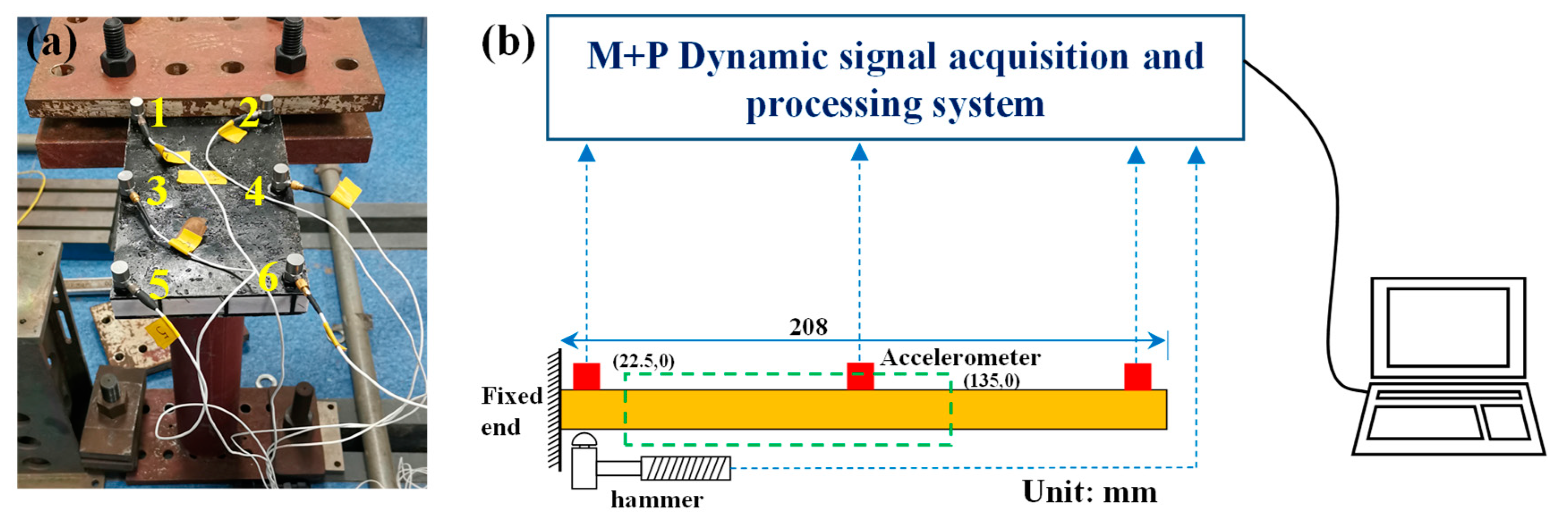
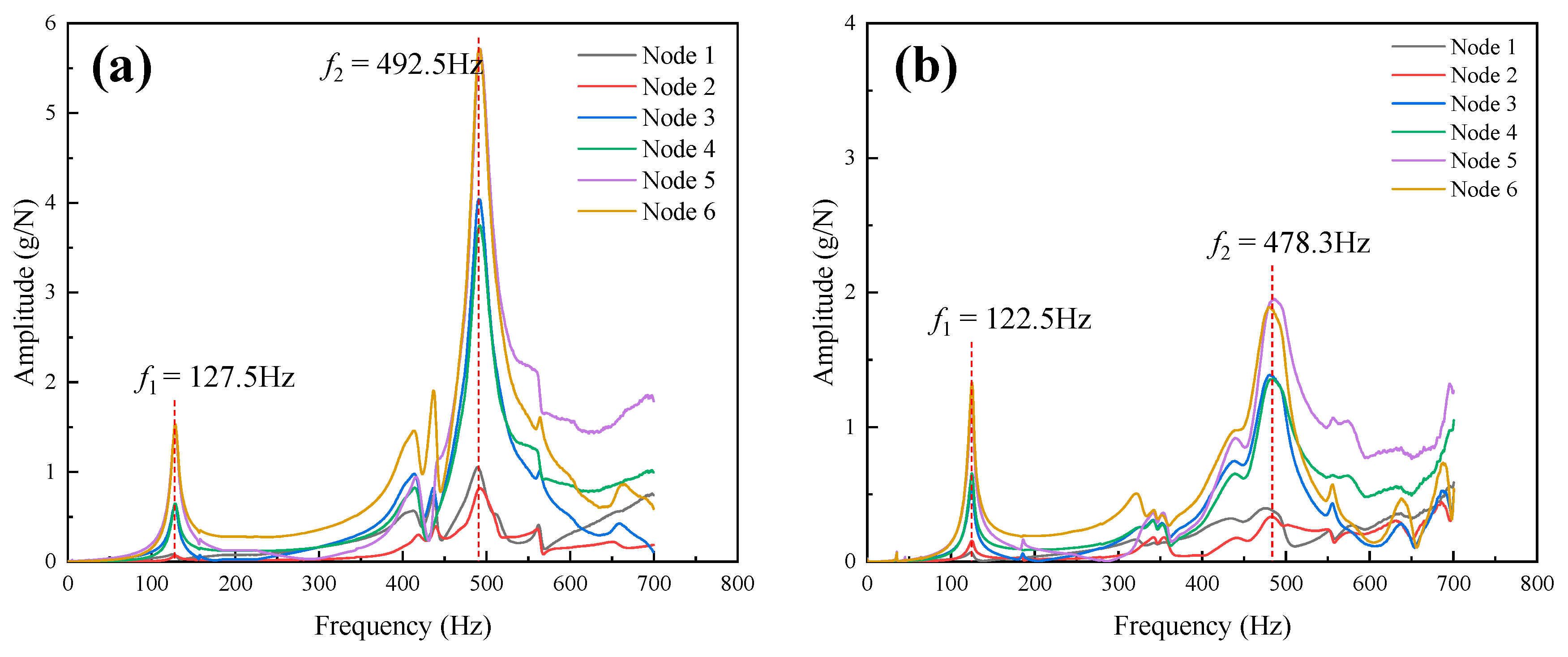

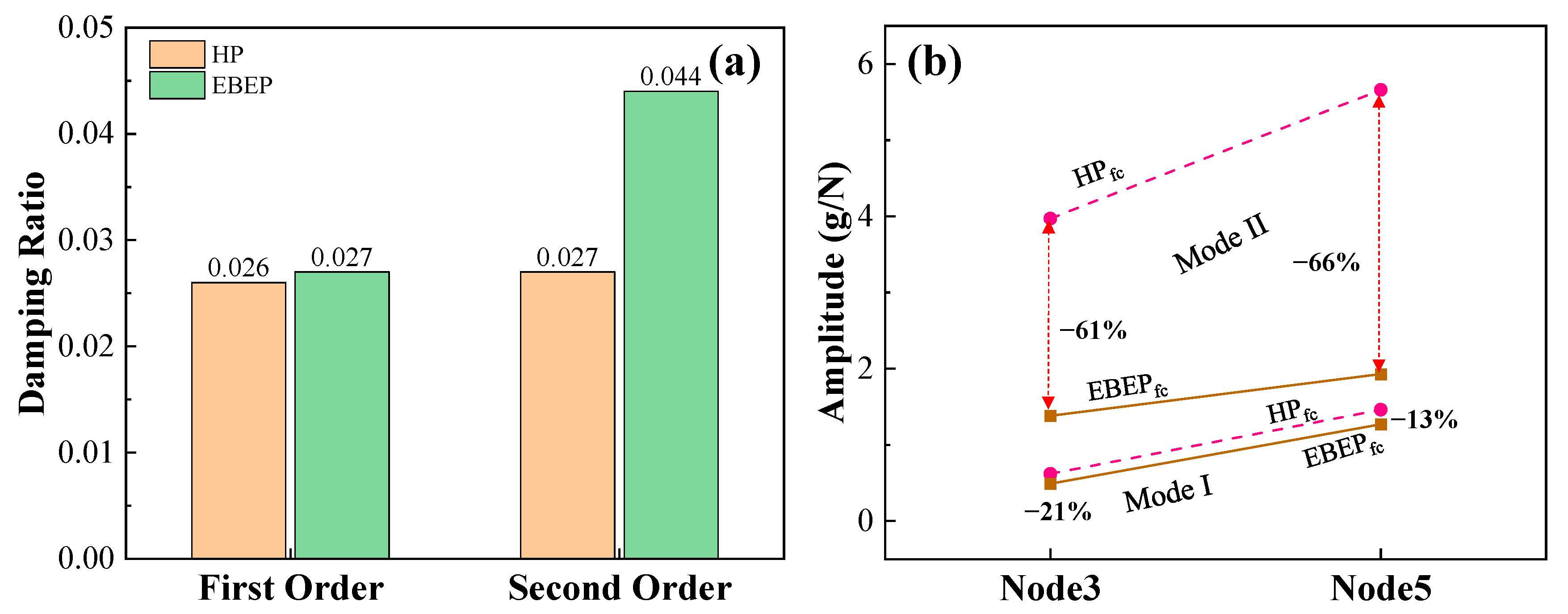

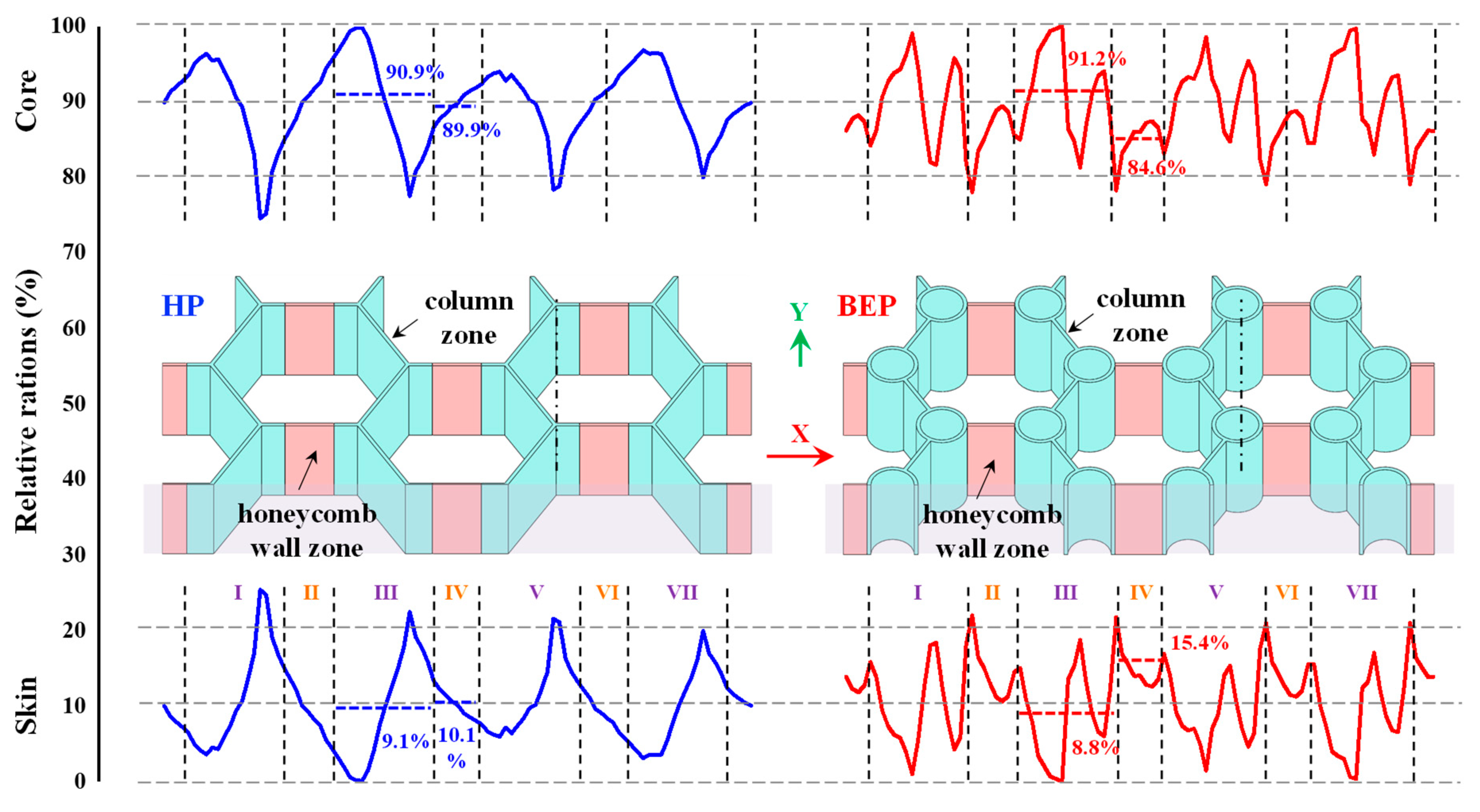
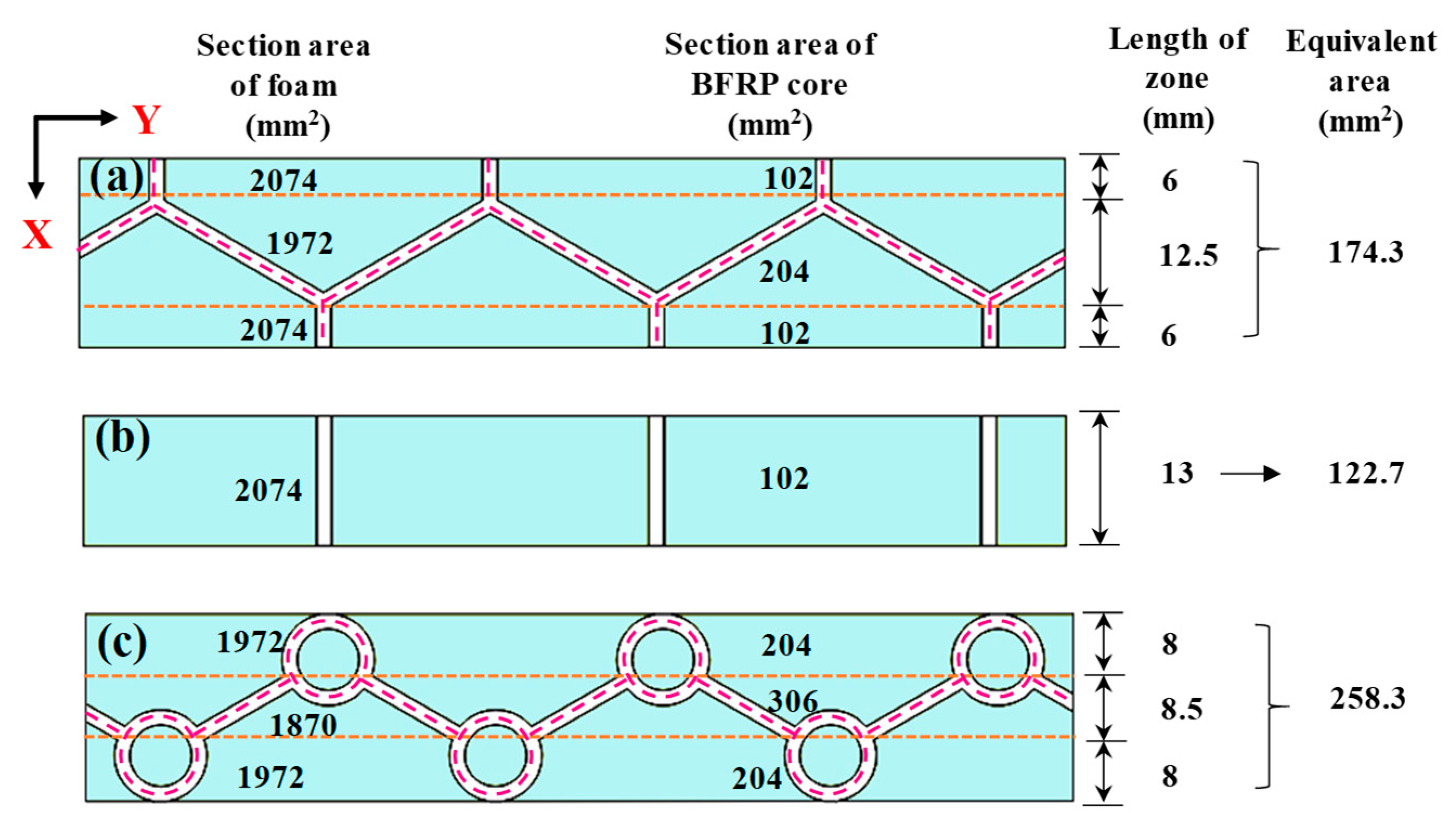
| Density (kg/m3) | Compressive Strength (MPa) | Elastic Modulus (MPa) | Poisson’s Ratio | |
|---|---|---|---|---|
| BFRP | 1550 | 111.9 | 3693 | 0.3 |
| PVC | 330 | 2 | 47 | 0.32 |
Publisher’s Note: MDPI stays neutral with regard to jurisdictional claims in published maps and institutional affiliations. |
© 2022 by the authors. Licensee MDPI, Basel, Switzerland. This article is an open access article distributed under the terms and conditions of the Creative Commons Attribution (CC BY) license (https://creativecommons.org/licenses/by/4.0/).
Share and Cite
Chen, J.; Du, S.; He, C.; Zhu, N. Vibrational Characteristics of a Foam-Filled Short Basalt Fiber Reinforced Epoxy Resin Composite Beetle Elytron Plate. Materials 2022, 15, 7748. https://doi.org/10.3390/ma15217748
Chen J, Du S, He C, Zhu N. Vibrational Characteristics of a Foam-Filled Short Basalt Fiber Reinforced Epoxy Resin Composite Beetle Elytron Plate. Materials. 2022; 15(21):7748. https://doi.org/10.3390/ma15217748
Chicago/Turabian StyleChen, Jinxiang, Shengchen Du, Chaochao He, and Nanxing Zhu. 2022. "Vibrational Characteristics of a Foam-Filled Short Basalt Fiber Reinforced Epoxy Resin Composite Beetle Elytron Plate" Materials 15, no. 21: 7748. https://doi.org/10.3390/ma15217748





